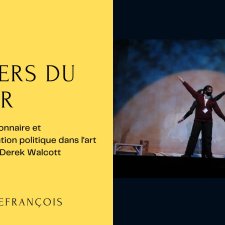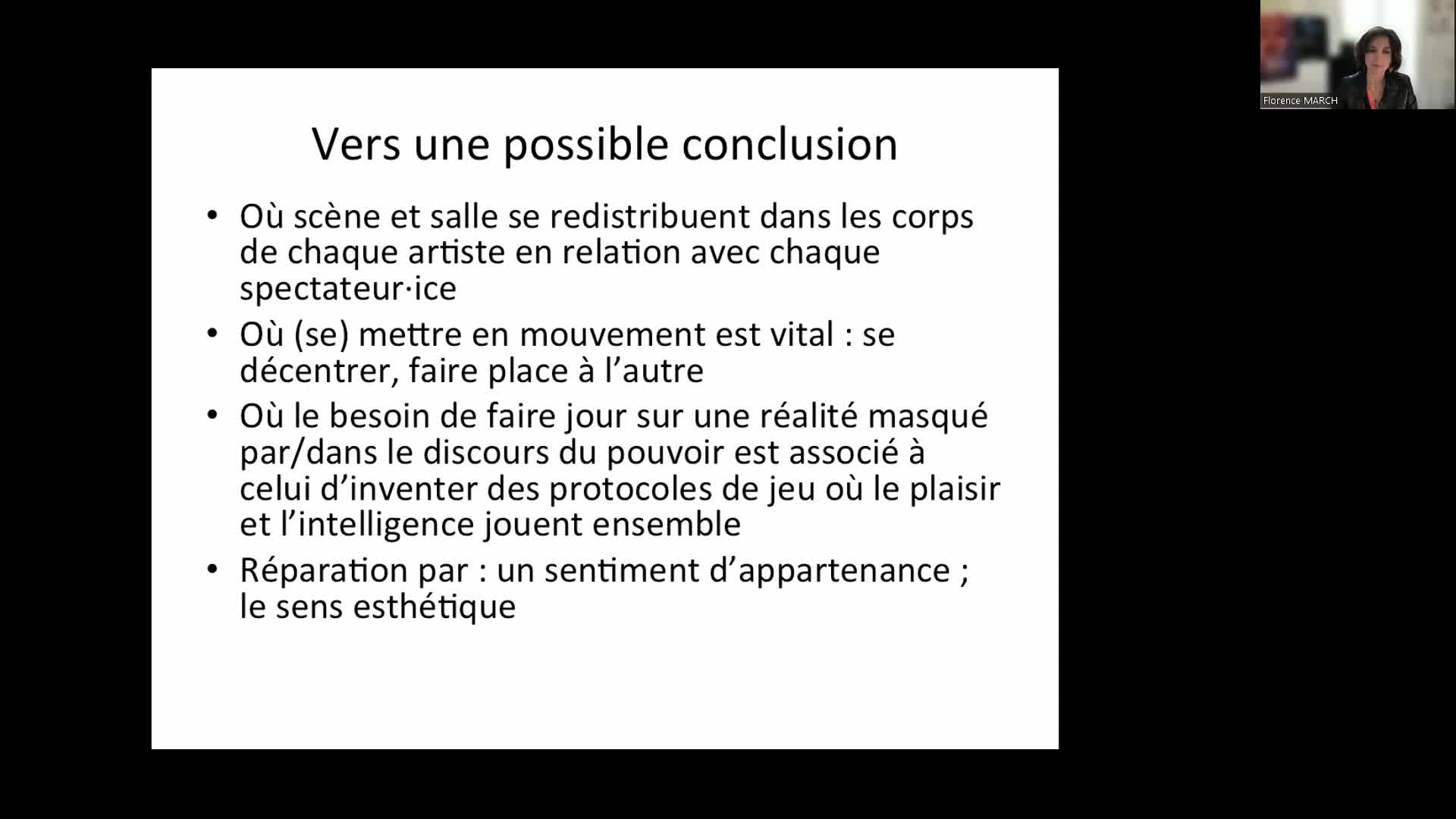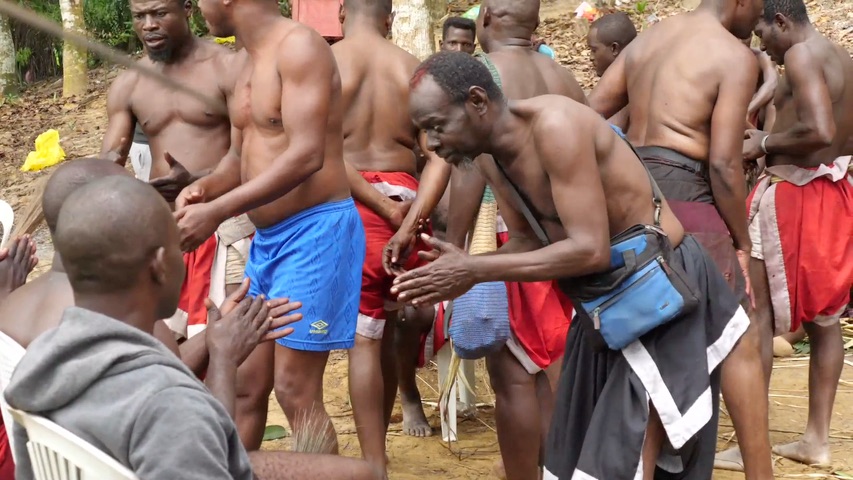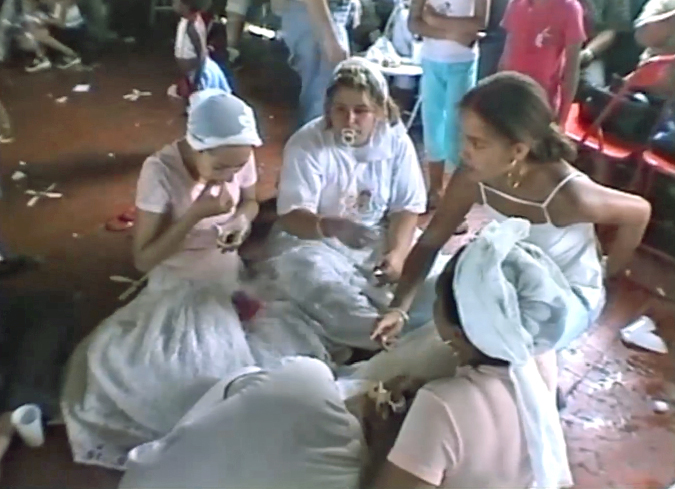Notice
“Quantifying JI” Short talk 1.2: Tommi Himberg - Mirroring improvised hand movements in a dyad
- document 1 document 2 document 3
- niveau 1 niveau 2 niveau 3
Descriptif
We studied coordination and movement kinematics in a mirror game. 32 participants (18 f, 14 m; mean age25.2 years, range 19–37) performed circledrawing and freely improvised hand movement mirroring tasks indyads. The participants were standing facetoface, right index fingers pointed at each other, fingertips10–15 cm apart. In turn, one of the participantswas appointed the leader, or the dyad was instructed to share leadership. Hand movements were recordedusing an optical motion capture system. Joint leadership resulted in smoother performances than theleader–follower condition; the follower participant would often hesitate or correct their movements, resultingin oscillatory 2–3 Hz jitter. In joint leadership tasks this jitter was 23% lower than in followers (p < 0.01). Thiscorresponds with the “coconfidentmotion” observed in joint leadership mirror task by Noy et al. (2011). In leaderfollower tasks the followertrailed the leader by approximately 0.3 seconds. Joint leadership trials resulted in mutual adaptation, withboth participants “following” each other at similar lags. Windowed analysis revealed that the direction of thelag varied at subsecond intervals. Hand movements were faster in circle drawing than in free improvisation,but there were no velocity differencesbetween the leadership conditions. These findings imply that dyads that share leadership perform smoothermovements and exhibit stronger mutual adaptation than dyads where one participant is externally assignedas the leader. Our study on coordination of threedimensional movements extends the scope of previousdyadic interaction studies that used rhythmic tapping and 1D movements.
Intervention / Responsable scientifique
Thème
Documentation
Liens
Dans la même collection
-
Joint Improvisation Meetings 2015
We understand joint improvisation as an artistic form involving two or more performers engaging in multiple real-time interactions: with each other, with the audience and with the emerging content.
-
-
“Beneficial JI” - Short talk 2.3: Rachel-Shlmoit Brezis - Testing the limits – and potential of joi…
Shlmoit-BrezisRachelResearch on joint improvisation has shown that expert improvisers, as well as neurotypical individuals, canjointly create novel complex motion, synchronized to less than 180ms.
-
From me and you to we: how our brain integrates our actions and emotions when we interact
GazzolaValeriaIt is now well known that areas in the brain that are active when we act or feel become active again when weobserve other people act and express their emotions – as if we would internally relivewhat
-
Deconstructing “joint improvisation”
BrownStevenWhat is “joint” and what is “improvisational” about joint improvisation? The “joint” aspect can be contrastedwith solo improvisation, such as that of a jazz pianist. Even when jazz pianists improvise
-
“Quantifying JI”Short talk 1.1: Saul Albert - Extemporary movement: an interactional account of par…
AlbertSaulClear empirical distinctions can be drawn between joint improvisation and choreography in dance by exploring the rhythmical coordination of dancers and audience members in a partner dance performance
-
“Beneficial JI” - Short talk 2.1: Neta Spiro - Joint improvisation in music therapy: characterising…
SpiroNetaSome types of music therapy, such as Nordoff Robbins, involve improvisation by the client and therapist andthe relationship between the participants’ music making is prioritised. Some children with a
-
Improvising in Sign Language and Gestures
CitronAtiThe Sign Language Theatre Laboratory is a practicebasedartistic research group that began operating in2014 as part of the Grammar of the Body (GRAMBY) Interdisciplinary Research Project led by
-
Joint Improvisation in Music and Dance: Some Preliminary Phenomenological Considerationson Improvis…
Magrin-ChagnolleauIvan"I have been a practitioner of soloandjointimprovisationin music and dance for a while. And I have alwayswondered what the main differences were between the two. What I am particularly interested in
-
-
Brain to Brain approaches to joint actions
KeysersChristianJoint actions require an ability to understand and predict the actions of others far enough into the future to have time to plan and execute matching motor programs. Here I will review experiments in
-
Operationalizing Social Neuroscience through HumanHuman and HumanMachine Interactions
DumasGuillaumeHow are neural, behavioral and social scales coordinated in real time so as to make possible the emergenceof social cognition? Answering this question requires to study the dynamics of coordination in
Avec les mêmes intervenants et intervenantes
-
Qui prend soin ? Care et pandémie dans une perspective transnationale - 3e partie
GottfriedHeidiAcciariLouisaGuimarãesNadya AraujoMilkmanRuthHirataHelena SumikoRedondoMichelle FrancoCe colloque met en lumière les expériences vécues des travailleuses du care dans les hôpitaux, maisons de retraite, ou à domicile mais aussi d’interroger les réponses des États et autres acteurs
-
Qui Prend Soin - Care et pandémie dans une perspective transnationale
HirataHelena SumikoDamammeAurélieEydouxAnnePineda DuqueJavier ArmandoSoaresAngeloMolinierPascaleCare et pandémie dans une perspective transnationale » vise à présenter les premiers résultats d’un projet de recherche international réalisé dans 6 pays : le Brésil, le Canada, la Colombie, les Etats
-
"Pensées critiques du genre : travail, corps, nation " Décloisonner le travail 1
HirataHelena SumikoMilleMurielKergoatDanièleBourguignonAbigailColloque international « Pensées critiques du genre : travail, corps, nation » Le colloque international « Pensées critiques du genre : travail, corps, nation » a pour but de présenter le vaste
-
"Pensées critiques du genre : travail, corps, nation " Décloisonner le travail 4
HirataHelena SumikoBercotRégineRomerioAliceBoufraiouaLeilaColloque international « Pensées critiques du genre : travail, corps, nation » Le colloque international « Pensées critiques du genre : travail, corps, nation » a pour but de présenter le vaste
-
"Pensées critiques du genre : travail, corps, nation " Décloisonner le travail 2
HirataHelena SumikoMilleMurielKergoatDanièleBourguignonAbigailColloque international « Pensées critiques du genre : travail, corps, nation » Le colloque international « Pensées critiques du genre : travail, corps, nation » a pour but de présenter le vaste
-
"Pensées critiques du genre : travail, corps, nation " Décloisonner le travail 3
HirataHelena SumikoRomerioAliceColloque international « Pensées critiques du genre : travail, corps, nation » Le colloque international « Pensées critiques du genre : travail, corps, nation » a pour but de présenter le vaste
Sur le même thème
-
Danse et handicap #1 - Danser et vivre les yeux fermés : aller au bout de ses rêves
HaustantFabienneDanse et handicap #1 - Danser et vivre les yeux fermés : aller au bout de ses rêves
-
L'envers du décor: rhéthorique visionnaire et instrumentalisation politique dans l'art dramatique d…
LefrançoisFrédéricL'envers du décor: rhéthorique visionnaire et instrumentalisation politique dans l'art dramatique de Derek Walcott
-
Faire exister les nouvelles attentions : atelier de Julie Perrin et Pascale Gille
PerrinJulieGillePascalePar un atelier et une discussion, Julie Perrin et Pascale Gille soulignent comment les danseurs et danseuses continuent de faire bouger les lignes du "partage du sensible", en jouant de la frontière
-
Faire corps avec le document : les chorégraphes contemporains face aux crises et aux conflits
Cette communication se centre autour de pièces chorégraphiques qui abordent des situations de crises politiques, économiques, humaines, à travers des matériaux documentaires. Il s’agit de dresser un
-
Les formes de réparation dans les arts de la scène à l’épreuve de la Covid-19 (visio)
RiedlerJulietteBurighelGiuseppeLe webinaire propose un retour sur la journée d’étude et de pratiques artistiques " Les formes de réparation dans les arts de la scène à l’épreuve de la Covid-19 " (qui s’est déroulé le 23 mars 2022 –
-
Après la projection - Discussion autour de « Faraway My Shadow Wandered » de Liao Jiekai et Sudhee …
CheurfaCéliaJiekaiLiaoLiaoSudheeDiscussion avec les réalisateurs Liao Jiekai et Sudhee Liao, en dialogue avec Jean-Michel Butel, ethnologue, maître de conférences à l'Inalco, spécialiste des évolutions sociales et des structures
-
-
Cérémonies et rituels de l’umbanda : la fête des enfants Marília, État de São Paulo Brésil, les 13 …
JacquemotArmelleTerreiro du Vieux-noir Pai Fabiano, Marília, État de São Paulo (Brésil), les 13 et 14 octobre 2001
-
Corps dansant et corps bourgeois : la fabrique des normes au XIXe siècle
MarquerBertrandJarrasseBénédicteConférences | Vendredi 15 novembre Bertrand Marquer | La norme et l’écart : imaginaire et savoirs du corps au XIXe siècle Bénédicte Jarrasse | Corps-machines : la danse et l
-
-
-































